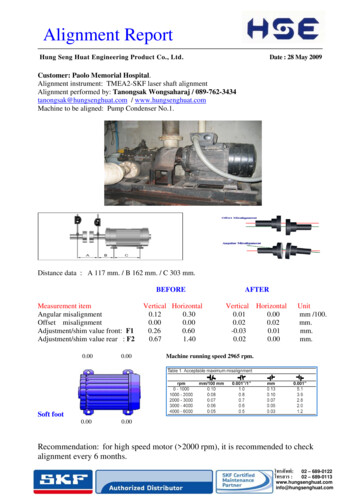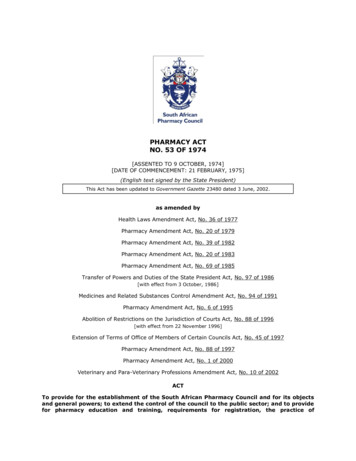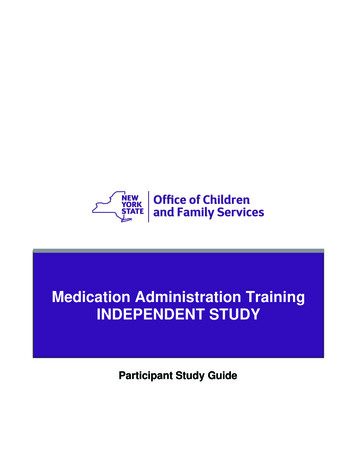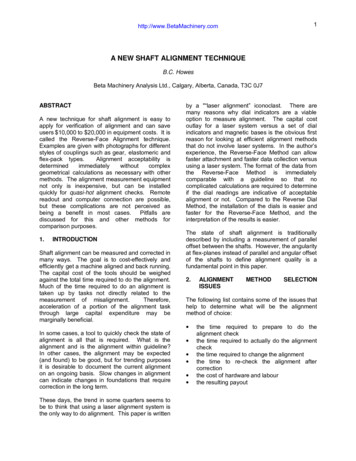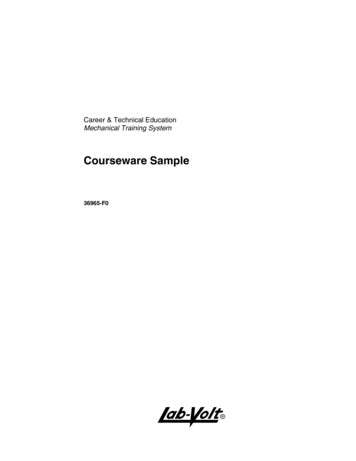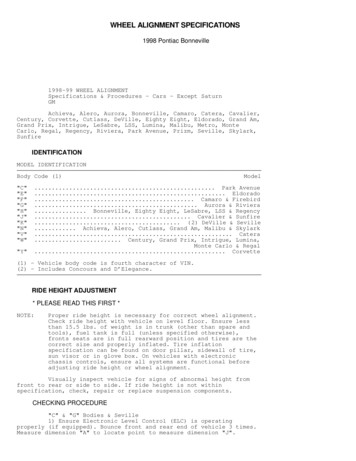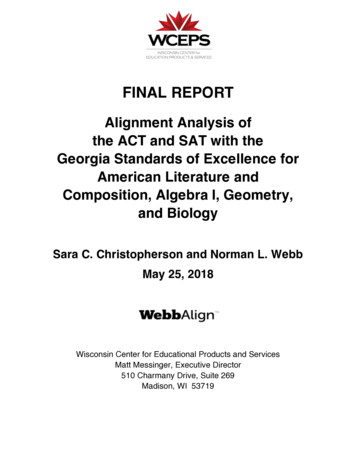
Transcription
FINAL REPORTAlignment Analysis ofthe ACT and SAT with theGeorgia Standards of Excellence forAmerican Literature andComposition, Algebra I, Geometry,and BiologySara C. Christopherson and Norman L. WebbMay 25, 2018Wisconsin Center for Educational Products and ServicesMatt Messinger, Executive Director510 Charmany Drive, Suite 269Madison, WI 53719
AcknowledgementsAlgebra I:External PanelistsLinda McQuillenGroup LeaderWisconsinDiane BriarsPennsylvaniaMichael KestlerWashington, D.CGeorgia PanelistsBobby DanielsDecatur County, GAKelley FlournoyFayette County, GAMeg JettOconee County, GAMelissa SchubertEvans County, GASrinivasan ThiyagarajanRichmond County, GAGeometry:External PanelistsLynn RaithGroup LeaderPennsylvaniaLinda HallWashington, D.CJackie SnyderPennsylvaniaGeorgia PanelistsWendy DyerGwinnett County, GAMary GuyThomas County, GALeigh MooreLaurens County, GAClaire SarverOconee County, GAMichelle TaiseePaulding County, GAiii
American Literature and CompositionExternal PanelistsCindy JacobsonGroup LeaderWisconsinGreg BartleyWisconsinKymyona BurkeMississippiGeorgia PanelistsBrandi AnthonyToombs County, GAMeshka BaileyForsyth County, GAChristine BrandFayette County, GAKimberly HernandezBibb County, GAAlex PapanicolopoulosGrady County, GABiology:External PanelistsJohn PutnamGroup LeaderVirginiaNorman DahmIllinoisJim WoodlandNebraskaGeorgia PanelistsPaula CooperLumpkin County, GAMary-Melissa MayGilmer County, GATheresa SenechekGriffin-Spalding County, GAHeather ToliverHenry County, GAThe Georgia Department of Education, Atlanta, Georgia, funded this analysis. Dr. AllisonTimberlake, Deputy Superintendent for Assessment and Accountability and Jonathan D.Rollins III, Measurement Program Manager for Assessment & Accountability, were themain contacts. Many other staff were also involved in the coordination of the alignmentanalysis.iv
Table of ContentsTable of ContentsExecutive Summary . 3Introduction and Methodology . 5Training and Coding . 6Data Analysis . 9Alignment Criteria Used for This Analysis . 10Reporting Categories and Standards . 10Mapping of Items to Standards . 12Categorical Concurrence . 12Depth-of-Knowledge Consistency . 13DOK Levels . 13Range-of-Knowledge Correspondence . 20Balance of Representation . 20Source of Challenge. 21Cutoffs for Alignment Criteria . 21Findings: American Literature and Composition . 22Framework Analysis for ELA . 22Standards . 24Mapping of Items to Standards . 25Comparison of Overall DOK Distribution . 26Alignment Statistics and Findings . 26Results by Test Form . 27Reliability among Reviewers . 32Findings: Algebra I . 33Framework Analysis for Mathematics – Algebra I. 33Standards . 35Mapping of Items to Standards . 361
Comparison of Overall DOK Distribution . 37Alignment Statistics and Findings . 37Results by Test Form . 38Reliability among Reviewers . 47Findings: Geometry . 49Framework Analysis for Mathematics – Geometry . 49Standards . 51Mapping of Items to Standards . 52Comparison of Overall DOK Distribution . 55Alignment Statistics and Findings . 55Results by Test Form . 56Reliability among Reviewers . 64Findings for Biology . 66Framework Analysis for Science – Biology . 66Standards . 66Mapping of Items to Standards . 68Alignment Statistics and Findings . 68Results by Test Form . 68Reliability among Reviewers . 71Conclusion . 73References . 74For each content area:Appendix A: Group Consensus DOK Values for Georgia Standards of ExcellenceAppendix B: Data Analysis Tables for Each Test FormAppendix C: Reviewers’ NotesAppendix D: Debriefing Summary NotesAppendix E: Framework AnalysisAppendix F: DOK Definitions for Reading, Mathematics, and Science2
Executive SummaryThis report describes a two-stage alignment analysis conducted during the month ofFebruary, 2018, to provide information about the degree of alignment of the ACT andSAT with the Georgia Standards of Excellence (GSE). The content analysis wasconducted to help inform a decision about whether or not school districts might be ableto use either or both of these nationally-recognized college entrance tests in place of theGeorgia Milestones End-of-Course assessments for American Literature andComposition, Algebra I, Geometry, and Biology. Evidence from this alignment study,along with evidence from other studies that the state of Georgia commissioned, will helpthe state to understand if the ACT and/or SAT could be used in lieu of the GeorgiaMilestones EOC assessments for fulfilling requirements as stated in Federal statute andGeorgia legislation.The alignment analysis consisted of two stages:Stage I: An analysis of ELA, mathematics, and science assessment frameworkdocuments; andStage II: An in-person content alignment institute.The first stage of the two-part alignment study compared the differences and similaritiesin the frameworks used to develop or interpret the findings from the ACT, SAT, andGeorgia Milestones assessments. This information about the assessment structures anddesigns allowed for an analysis of convergent and divergent findings across the SAT andACT when compared with the GSE with respect to the similarity of the constructs beingmeasured. The ELA analysis was conducted by Dr. Erin Quast of Illinois StateUniversity, the mathematics analysis was conducted by Dr. Raven McCrory of MichiganState University, and the science analysis was conducted by Zoe Evans of Bowdon HighSchool, Bowdon, Georgia. The reports from the framework analysis can be found inAppendix E for each subject area. The second stage of the analysis was a three-day inperson alignment institute that was held from February 12-14, 2018, in Atlanta, GA, toanalyze the agreement between the Georgia Standards of Excellence for AmericanLiterature and Composition, Algebra I, Geometry and each of two forms of the ACT andthe SAT and the Georgia Standards of Excellence for Biology and each of three forms ofthe ACT. Five Georgia educators and three external reviewers agreed to participate ineach of the four subject-area analyses. Due to illness one Georgia biology educator wasnot able to participate. All panelists were selected because of their notable K-12education experience and content expertise.Overall, none of the test forms were found to be aligned with the GSE for any of thesubjects. The ACT and SAT test forms had the greatest overlap with the GSE forAmerican Literature and Composition and limited overlap with the standards for othercourses. For American Literature and Composition, one of the ACT test forms was foundto need slight adjustments—defined as needing six to 10 items revised or replaced—tomeet the minimum cutoffs for full alignment. The other ACT test form was found to needmajor adjustments—defined as needing more than 10 items revised or replaced—tomeet minimum alignment criteria. The ACT test forms reviewed would requireapproximately eight or approximately 16 items revised or replaced to meet minimumlevels of acceptable alignment with the GSE for American Literature and Composition.3
Both SAT test forms were found to need major adjustments to meet minimum levels ofacceptable alignment with the GSE for American Literature and Composition, requiringapproximately 13 or approximately 14 items revised or replaced.The mathematics portions of both ACT and both SAT test forms analyzed would requiremajor adjustments to meet minimum cutoffs for alignment with the corresponding GSE(for Algebra I or for Geometry). For the ACT test forms, only about 13% of items (8 of 60items) or 23% of items (14 of 60 items) were judged by a majority of reviewers tocorrespond to an Algebra I standard. Only about 32% of ACT items (19 of 60 items) oneach test form were judged by a majority of reviewers to correspond to a Geometrystandard. For the SAT test forms, only about 62% of items (36 of 58 items) or 53% ofitems (31 of 58 items) were judged by a majority of reviewers to correspond to anAlgebra I standard. Only about 16% of SAT items (9 of 58 items) on each test formcorresponded to Geometry standards.For Biology, none of the three ACT test forms were aligned with the GSE. Only 8%,18%, or 20% of items corresponded to the GSE for Biology.While augmenting the ACT or SAT to gain an acceptable level of alignment is certainlypossible, it should be noted that augmentation tends to be a rather expensive processand adds complexity to the administration of the tests, since items used to augment atest need to be administered separately from the college entrance test. Without suchaugmentation, however, these tests might not be viewed as meeting the United StatesEducation Department (USED) criteria for aligned tests, thus jeopardizing the approval ofthe use of the college admissions tests in the federal requirements and the assessmentpeer review process.4
Introduction and MethodologyThe alignment of expectations for student learning with assessments for measuringstudents’ attainment of these expectations is an essential attribute for an effectivestandards-based education system. Alignment is defined as the degree to whichexpectations and assessments are in agreement and serve in conjunction with oneanother to guide an education system toward students learning what they are expectedto know and do. As such, alignment is a quality of the relationship between expectationsand assessments and not an attribute solely of either of these two system components.Alignment describes the match between expectations and an assessment that can belegitimately improved by changing either student expectations or the assessments. As arelationship between two or more system components, alignment is determined by usingthe multiple criteria described in detail in a National Institute for Science Education(NISE) research monograph, Criteria for Alignment of Expectations and Assessments inMathematics and Science Education (Webb, 1997). The corresponding methodologyused to evaluate alignment has been refined and improved over the last 20 years,yielding a flexible, effective, and efficient analytical approach.This is a report of a two-stage alignment analysis in the areas of American Literature andComposition, Algebra I, Geometry, and Biology that was conducted during the month ofFebruary, 2018, to provide information that could be used to judge the degree to whichthe ACT or SAT were aligned with the Georgia Standards of Excellence (GSE) used todevelop the corresponding Georgia Milestones assessments. As such, the study focusedon the degree to which the ACT and SAT test forms provided addressed the full depthand breadth of the GSE used to develop the Georgia Milestones assessments forAmerican Literature and Composition, Algebra I, Geometry, and Biology.The alignment analysis consisted of two stages:Stage I: An analysis of ELA, mathematics, and science assessment frameworkdocuments; andStage II: An in-person content alignment institute.The Stage I framework analysis for ELA was conducted by Dr. Erin Quast of Illinois StateUniversity, the framework analysis for mathematics was conducted by Dr. RavenMcCrory of Michigan State University, and the framework analysis for science wasconducted by Zoe Evans of Bowdon High School, Bowdon, Georgia. Each subject areaeducation expert analyzed the specification of content in supporting documents for eachof the ACT, SAT, and Georgia Milestones, including blueprints, item specifications, itemtype, and other relevant materials that were used in developing tests or interpretingscores. The framework analysis yielded a comparison of overall test claims andassessment targets, descriptions of how specific terms and concepts were used in eachof the frameworks, and identification of any relevant structural variation among the threeframeworks for each content area including any differences in item types, emphasis incontent topics, type of reading passages used, sizes of numbers used, and other factors.Contextual factors such as the allotted time for essay writing were also considered. Fullreports from the framework analysis are included in Appendix E of this report for eachsubject area. Findings from the framework analyses are also summarized in the Findingssection of this report.5
The Stage II in-person content alignment institute was held over three days, February12-14, in Atlanta, GA, at the Courtyard by Marriott Atlanta Decatur Downtown/Emory.The ELA and mathematics portions of two test forms of each of the ACT and SAT werereviewed at the institute. Three test forms of the ACT science test were also reviewed.Eight reviewers served on each of the ELA, Algebra I, and Geometry panels. Sevenreviewers served on the Biology panel; one Georgia panelist was not able to attend dueto illness. An experienced group leader facilitated each panel. Study director NormanWebb is the researcher who developed the alignment study procedures and criteria(through the National Institute for Science Education in 1997, funded by the NationalScience Foundation, and in cooperation with the Council of Chief State School Officers)that influenced the specification of alignment criteria by the U.S. Department ofEducation. The Webb alignment process has been used to analyze curriculum standardsand assessments in at least 30 states to satisfy or to prepare to satisfy Title I complianceas required by the United States Department of Education (USED). Study TechnicalDirector Sara Christopherson has participated in and led Webb alignment studies since2005 for state departments of education as well as for other entities.The Version 2 of the Web Alignment Tool (WATv2) was used to enter all of the contentanalysis codes during the institute. The WATv2 is a web-based tool connected to theserver at the Wisconsin Center for Education Research (WCER) at the University ofWisconsin-Madison. It was designed to be used with the Webb process for analyzing thealignment between assessments and standards. Prior to the institute, a group numberwas set up on the WATv2 for each of the four panels. Each panel was assigned one ormore group identification numbers and the group leader was designated. Then thereporting categories and standards were entered into the WATv2 along with theinformation for each assessment, including the number of items, the weight (point value)given to each item, and additional comments such as the identification number for theitem to help panelists find the correct item. A sequential account of the alignment studyprocedures is provided below.Training and CodingIn the morning of the first day of the alignment institute, reviewers in all four content areagroups received an overview of the purpose of their work, the coding process, andgeneral training on the Depth-of-Knowledge (DOK) definitions used to describe contentcomplexity. All reviewers had some understanding of the DOK levels prior to theinstitute. The general training at the alignment institute was crafted to contextualize theorigins of DOK (to inform alignment studies of standards and assessments) and purpose(to differentiate between and among degrees of complexity), and to highlight commonmisinterpretations and misconceptions to help reviewers better understand and,therefore, consistently apply the depth of knowledge (DOK) language system. Panelistsalso practiced assigning DOK to sample assessment items that were selected to fosterimportant discussions that promote improved conceptual understanding of DOK.Appropriate training of the panelists at the alignment institute is critical to the success ofthe project. A necessary outcome of training is for panelists to have a common,calibrated understanding of the DOK language system for describing categories ofcomplexity.6
The groups were then separated into different rooms to receive more detailed training onthe DOK levels for each content area. Through interactive and participatory training,panelists reviewed the content area-specific definitions of the four DOK levels andworked toward a common understanding of the difference between and among each ofthe levels of complexity. Because the two mathematics groups used the same DOKdefinitions, they completed this portion of the training together, to promote consistencybetween the two groups’ use of DOK as it pertains to mathematics. Definitions for eachDOK level for ELA, mathematics, and science are included within this report. Reviewersthen worked to calibrate their use of DOK to evaluate the complexity of a subset of thestandards, first assigning DOK individually and then participating in a consensusdiscussion. After completing coding and discussion of the subset, the panelists reviewedthe DOK levels previously assigned to the standards, when available (completed byother expert panels using a similar process) and flagged any standards that they wantedto discuss further, that they thought needed clarification, and/or that had a DOKassigned that they thought should be considered for adjustment because it did notaccurately depict the appropriate level of content complexity. Group leaders facilitateddiscussions for any standards that one or more panelists flagged. If the discussionresulted in a decision to change the DOK that was assigned to a standard, then thatchange was made in the online data collection system, the WATv2. This study includedall standards identified by Georgia that defined the expectations for the correspondinghigh school courses: American Literature and Composition, Algebra I, Geometry, andBiology.The Georgia Standards of Excellence for American Literature and Composition, AlgebraI, and Geometry were derived from the Common Core State Standards (CCSS) and cantherefore be considered as meeting the requirement of high quality standards related tocollege and career readiness. The Georgia Standards of Excellence for Biology aregrounded in Project 2061’s Benchmarks for Science Literacy (1993) and the NationalResearch Council’s A Framework for K-12 Science Education (2012). These conceptualframeworks for science education are intended to prepare students to be scientificallyliterate adults, prepared to pursue post-secondary education and/or careers in thesciences. As such, the GSE for Biology can also be considered as meeting therequirement of high quality standards related to college and career readiness.After thoroughly discussing the standards and coming to consensus on the intendedcomplexity of each standard, panelists then conducted individual analyses of 3-5assessment items from the first ACT test form and the first SAT test form (for ELA andmathematics groups). For each item, panelists worked individually to assign a DOK levelto the item and then to code each item to the standard that they judged the item tomeasure, i.e. what students are expected to know or do in order to respond to thequestion. Up to three standards could be coded as corresponding to each item.Following individual analyses of the items, reviewers participated in a debriefingdiscussion in which they analyzed the degree to which they had coded particular itemsor types of content to the standards. This overall process was repeated at the start ofeach test form to maintain calibration within each group of reviewers. Reviewers thencompleted analysis of the remaining items individually for each test form.7
As reviewers work, they become increasingly familiar with the standards. They alsorefine their approach to interpretation and analysis of content. To ensure that the noviceeffect would be equally distributed across both the ACT and SAT test forms, half of theELA and math groups’ panelists coded the ACT first and half of the groups’ panelistscoded the SAT first for each test form.Reviewers were instructed to focus primarily on the alignment between the GSE and theassessment items on the ACT and SAT test forms. However, reviewers wereencouraged to offer their opinions on the standards or on the assessment tasks bywriting a note about the item in the appropriate text box in the WATv2 data collectiontool. Reviewers were instructed to enter a note into the WATv2 for an assessment item ifthe item only corresponded to a part of a standard and not the full standard. Thus, thereviewers’ notes can be used to reveal if assessment items only targeted a part of theindividual standards. Reviewers also could indicate whether there was a Source-ofChallenge issue with an item—i.e. a technical problem with the item that might cause thestudent who knows the material to give a wrong answer or enable someone who doesnot have the knowledge being tested to answer the item correctly. No Source-ofChallenge issues were identified on any of the assessments.Reviewers engaged in adjudication of their results after completing the coding of eachtest form. After discussing an item, the reviewers were given the option to make changesto their codings, but were not required to make any changes if they thought their codingwas appropriate. After all of the reviewers completed coding an assessment form, thestudy director and group leader identified the assessment items that did not have amajority of reviewers in agreement on DOK or where the reviewers differed significantlyon the DOK assigned (e.g. three different DOK values were assigned). When thesesubstantial disagreements occur, it suggests that reviewers are either interpreting theDOK definitions in very different ways or are interpreting the particular assessment itemin very different ways.Reviewers also discussed items for which there were great differences in coding to astandard. The adjudication process helped panelists identify and correct any errors incoding (e.g. accidentally assigning an item to a standard that they did not intend toassign). Adjudication also helped panelists build familiarity with the standards (e.g. areviewer might not have noticed that a particular expectation is explicit in one of thestandards) as well as build common interpretation of the standards (e.g. panelists maycalibrate their understanding of the meaning of certain standards that may be interpretedin different ways due to ambiguous wording or due to differences in the way peopleunderstand the content). Adjudication also helped reveal differences in interpretation ofassessment items, and helped reviewers to build a common understanding of exactlywhat content particular items were assessing. Overall, adjudication is intended to fosterfull and appropriate interpretation of the assessment items and standards, and to ensurethat panelists have coded their items as they intended. Reviewers were not required tochange their results after the discussion. Reviewer agreement statistics were computedafter adjudication and are included in the Findings section of this report.8
Reviewers were instructed to consider the full statement of expectations to consider if anassessment item should be mapped to a standard. In some cases, reviewers couldmake reasonable arguments for coding an item to different standards. For example, bothELAGSE11-12RL4 and ELAGSE11-12L4.a include the expectation that students usecontext clues to identify the meaning of unknown words and phrases.If reviewers map an item to a variety of standards it may also indicate that theassessment task may be inferred to relate to more than one standard but that the item isnot a close match. Reviewers may have difficulty finding where an item best fits when anassessment is coded to a set of standards that were not used in developing theassessment. If an item did not closely fit any standard, then the reviewers wereinstructed to code the item to a standard where there was a partial, but reasonable, fit orto a conceptual category level: the strand level for ELA GSE standards or domain levelfor mathematics GSE. Coding to the level of a conceptual category may be referred to ascoding to a “generic” standard.All seven biology reviewers coded all ACT science test forms and the biology groupadjudicated after completing each ACT test form. Math and ELA groups adjudicated afterthe first ACT and SAT forms were completed and then again after the second ACT andSAT forms were completed. Mathematics and ELA reviewers were working at differentpaces within their respective groups, and several reviewers were only able to completethree of the four test forms assigned. By the end of the time allotted for coding, eightELA reviewers coded ACT form 74C and seven ELA reviewers completed coding of ACTform A10. Eight ELA reviewers coded each of the two SAT test forms (April and October2017). Seven algebra reviewers coded each of ACT form 74C and form A10. Eightalgebra reviewers completed coding SAT form April 2017 and seven algebra reviewerscompleted coding SAT form October 2017. Seven geometry reviewers completed SATtest form October 2017 and all eight reviewers competed the other three test forms.Data AnalysisTo derive the results from the analysis, the reviewers’ responses were averaged. First,the value for each of the four alignment criteria (described in the next section) wascomputed for each individual reviewer. Then the final reported value for each criterionwas found by averaging the values across all reviewers. Any variance among reviewerswas considered legitimate, for example, with the reported DOK level for an item fallingsomewhere between the two or more assigned values. Such variation could signifydifferences in interpretation of an item or of the assessed content and/or a DOK that fallsin between two of the four defined levels. Any large variations among reviewers in thefinal results represented true differences in opinion among the reviewers and were notbecause of coding error. These differences could be due to different standards targetingthe same content knowledge or may be because an item did not explicitly correspond toany standard, but could be inferred to relate to more than one standard. Standarddeviations are reported in the tables provided in Appendix B, which give one indicationof the variance among reviewers.9
The results produced from the institute pertain only to the issue of alignment betweenthe Georgia Standards of Excellence and the nine assessments that were analyzed.Note that an alignment a
For the SAT test forms, only about 62% of items (36 of 58 items) or 53% of items (31 of 58 items) were judged by a majority of reviewers to correspond to an Algebra I standard. Only about 16% of SAT items (9 of 58 items) on each test form corresponded to Geometry standards. For Biology, none of the three ACT test forms were aligned with the GSE.
